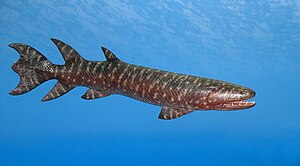Eotetrapodiformes
| Eotetrapodiformes | ||||||||||||
|---|---|---|---|---|---|---|---|---|---|---|---|---|

Live reconstruction of Eusthenopteron |
||||||||||||
| Temporal occurrence | ||||||||||||
| Middle Devon until today | ||||||||||||
| 387.7 to 0 million years | ||||||||||||
| Locations | ||||||||||||
|
||||||||||||
| Systematics | ||||||||||||
|
||||||||||||
| Scientific name | ||||||||||||
| Eotetrapodiformes | ||||||||||||
| Coates & Friedman , 2010 | ||||||||||||
The Eotetrapodiformes ( Greek : “eos” = dawn + Tetrapoda + Lat .: “Formes” = shape, figure) are a taxon of the meat fin (Sarcopterygii), in which the land vertebrates (Tetrapoda) with their nearest fish-like in the sense of the phylogenetic systematics Relatives are united. In addition to the terrestrial vertebrates, they include the Tristichopteridae , an extinct family of medium-sized to very large predatory fish from the middle and upper Devonian with the well-researched genus Eusthenopteron , as well as Platycephalichthys , Tinirau and the Elpistostegalia , the fish-like vertebrates that are most closely related to the terrestrial vertebrates. Michael I. Coates and Matt Friedman defined the Eotetrapodiformes in 2010 as a node-based definition, which includes the last common ancestor of Eusthenopteron and Ichthyostega and all of their descendants.
The following cladogram shows the likely relationships ( recent taxa in bold):
| Rhipidistia |
|
||||||||||||||||||||||||||||||||||||||||||||||||||||||||||||||||||||||||
|
|
Features that the fish-like Eotetrapodiformes and the early terrestrial vertebrates had in common are the labyrinthodontic teeth, which had an intricately folded dentin layer , the ossified ribs, an anterior palatal window, outer and inner nostrils and a "tetrapod joint", consisting of a spherical socket in the scapulocoracoid of the shoulder girdle and a spherical, towards the body (proximal) end of the humerus . In the group referred to above as “clade A”, the skull is more flattened, the eye openings are further on the top of the head and the unpaired fins (dorsal and anal fin, but the caudal fin initially not) are reduced.
All fish-like representatives of the Eotetrapodiformes are extinct. The closest recent fish relatives of the terrestrial vertebrates are the lungfish (Dipnoi).
Individual evidence
- ^ Michael I. Coates & Matt Friedman: Litoptychus bryanti and characteristics of stem tetrapod neurocrania. in DK Elliott, JG Maisey, X. Yu & D. Miao (eds.): Morphology, Phylogeny and Paleobiogeography of Fossil Fishes © 2010, Verlag Dr. Friedrich Pfeil, Munich, ISBN 978-3-89937-122-2
- ^ Brian Swartz: A Marine Stem-Tetrapod from the Devonian of Western North America. PLoS ONE 7, 2012, doi : 10.1371 / journal.pone.0033683
- ↑ Yu Xiaobo, Zhu Min & Zhao Wenjin: The Origin and Diversification of Osteichthyans and Sarcopterygians: Rare Chinese Fossil Findings Advance Research on Key Issues of Evolution. Bulletin of the Chinese Academy of Sciences, Paleoichthyology, Vol. 24 No. 2 2010, PDF
- ↑ a b Michael J. Benton : Paleontology of the vertebrates. 2007, Verlag Friedrich Pfeil, Munich 2007, pp. 83 and 85, ISBN 3-89937-072-4
- ↑ Hans Peter Schulze: Sarcopterygii, Fleischflosser , p. 301 in Wilfried Westheide , Reinhard Rieger : Special Zoology Part 2: Vertebrae and Skull Animals , 1st edition, Spectrum Academic Publishing House, Heidelberg • Berlin 2004, ISBN 3-8274-0307-3